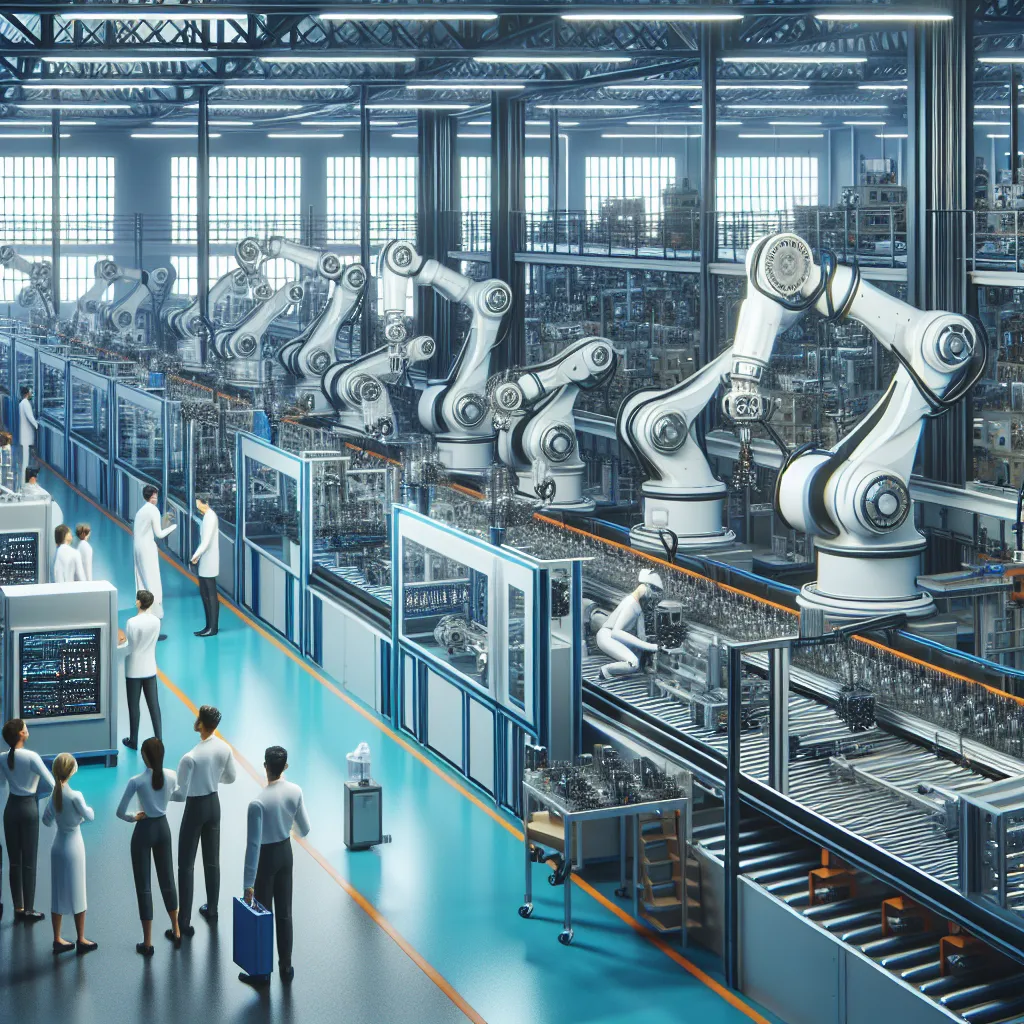The IELTS Reading section is a challenging component of the test, requiring candidates to demonstrate their comprehension skills across various topics. One such topic that has gained prominence in recent years is the effects of automation on manufacturing. This subject has appeared in past IELTS exams and, given its relevance in today’s rapidly evolving industrial landscape, is likely to resurface in future tests.
Table Of Contents
Based on an analysis of past IELTS exams and current trends, the topic of automation in manufacturing has shown a steady increase in frequency. Its contemporary nature and global impact make it a prime candidate for future IELTS Reading passages. As such, it’s crucial for test-takers to familiarize themselves with this subject to enhance their performance in the Reading section.
 Automated manufacturing process
Automated manufacturing process
IELTS Reading Practice Test
Reading Passage
The Transformative Impact of Automation on Manufacturing
The manufacturing sector has undergone a dramatic transformation in recent decades, largely due to the widespread adoption of automation technologies. This shift has had far-reaching consequences for productivity, employment, and the nature of work itself. While automation has been a part of manufacturing since the Industrial Revolution, the pace and scope of change have accelerated significantly in the 21st century.
One of the most notable effects of automation on manufacturing has been the substantial increase in productivity. Automated systems can operate continuously, with greater precision and at higher speeds than human workers. This has led to a significant boost in output and efficiency across various industries. For instance, in the automotive sector, robots can now assemble cars with remarkable speed and accuracy, reducing production times and improving quality control.
However, the rise of automation has also raised concerns about job displacement. As machines take over tasks previously performed by humans, there has been a decline in certain types of manufacturing jobs, particularly those involving repetitive or routine tasks. This shift has led to a restructuring of the workforce, with a growing emphasis on roles that require higher skills and technical expertise to operate and maintain automated systems.
Interestingly, while some jobs have been eliminated, automation has also created new employment opportunities. The design, implementation, and maintenance of automated systems require skilled workers, leading to an increased demand for engineers, technicians, and other specialists. This has resulted in a shift in the skill set required in modern manufacturing, with a greater focus on technical and analytical abilities.
The impact of automation extends beyond just employment numbers. It has fundamentally changed the nature of work in manufacturing. Workers are increasingly required to interact with complex machinery and interpret data from automated systems. This has led to a need for ongoing training and education to keep pace with technological advancements.
Moreover, automation has had significant implications for workplace safety. By taking over dangerous or physically demanding tasks, automated systems have reduced the risk of workplace injuries. This has not only improved worker safety but has also led to cost savings for companies in terms of reduced insurance premiums and lost work time.
The effects of automation are not limited to large-scale manufacturing. Small and medium-sized enterprises (SMEs) are also increasingly adopting automated technologies. While the initial investment can be substantial, many SMEs find that automation allows them to compete more effectively with larger companies by improving efficiency and quality.
Looking to the future, the trend towards automation in manufacturing is likely to continue and even accelerate. Emerging technologies such as artificial intelligence and machine learning are expected to further enhance the capabilities of automated systems. This ongoing evolution will undoubtedly bring new challenges and opportunities for the manufacturing sector and its workforce.
In conclusion, the effects of automation on manufacturing have been profound and multifaceted. While it has led to significant improvements in productivity and efficiency, it has also necessitated a reimagining of the workforce and the nature of work itself. As automation continues to evolve, its impact on manufacturing will undoubtedly remain a critical area of focus for industry leaders, policymakers, and workers alike.
Questions
True/False/Not Given
Do the following statements agree with the information given in the Reading Passage? Write
TRUE if the statement agrees with the information
FALSE if the statement contradicts the information
NOT GIVEN if there is no information on this
- Automation in manufacturing has led to a decrease in productivity.
- The automotive industry has seen improvements in production speed due to automation.
- All types of manufacturing jobs have declined due to automation.
- Automation has created new job opportunities in fields such as engineering and technical maintenance.
- Small and medium-sized enterprises find it impossible to adopt automated technologies.
Multiple Choice
Choose the correct letter, A, B, C, or D.
-
According to the passage, what is one of the main advantages of automated systems in manufacturing?
A) They require less maintenance
B) They can work continuously with high precision
C) They are cheaper to install than traditional systems
D) They eliminate the need for human workers entirely -
How has automation affected workplace safety in manufacturing?
A) It has increased the number of workplace injuries
B) It has had no significant impact on safety
C) It has reduced the risk of injuries by taking over dangerous tasks
D) It has made workplaces more dangerous due to complex machinery
Matching Headings
Match the following headings to the correct paragraphs in the passage. Write the correct number i-viii next to questions 8-10.
i. The future of automation in manufacturing
ii. The impact of automation on productivity
iii. Changes in required skill sets for manufacturing workers
iv. Automation’s effect on workplace safety
v. The adoption of automation by smaller companies
vi. The history of automation in manufacturing
vii. Job displacement concerns due to automation
viii. The global impact of automation on manufacturing
- Paragraph 2 ___
- Paragraph 5 ___
- Paragraph 7 ___
Answer Key and Explanations
-
FALSE
Explanation: The passage states that automation has led to a “substantial increase in productivity,” which contradicts the statement. -
TRUE
Explanation: The passage mentions that “in the automotive sector, robots can now assemble cars with remarkable speed and accuracy, reducing production times.” -
FALSE
Explanation: While some jobs have declined, the passage notes that automation has also created new employment opportunities, particularly in technical fields. -
TRUE
Explanation: The passage explicitly states that automation has created new employment opportunities in fields such as engineering and technical maintenance. -
NOT GIVEN
Explanation: The passage mentions that SMEs are adopting automated technologies, but it doesn’t state that they find it impossible to do so. -
B
Explanation: The passage states that “Automated systems can operate continuously, with greater precision and at higher speeds than human workers.” -
C
Explanation: The passage mentions that automation has “reduced the risk of workplace injuries” by taking over dangerous tasks. -
ii
Explanation: Paragraph 2 focuses on how automation has increased productivity in manufacturing. -
iii
Explanation: Paragraph 5 discusses how the nature of work has changed, requiring new skills from workers. -
v
Explanation: Paragraph 7 talks about the adoption of automation technologies by small and medium-sized enterprises.
Common Mistakes and How to Avoid Them
-
Misinterpreting “Not Given” answers: Many test-takers confuse “False” with “Not Given.” Remember, “Not Given” means the information is not mentioned in the passage at all.
-
Overlooking key words: Pay close attention to qualifiers like “all,” “some,” “never,” etc. These can change the meaning of a statement significantly.
-
Falling for distractors in multiple-choice questions: Read all options carefully and choose the one that best matches the information in the passage.
-
Mismatching headings: Ensure you understand the main idea of each paragraph before matching it with a heading.
Key Vocabulary
- Automation: /ˌɔːtəˈmeɪʃn/ (noun) – the use of automatic equipment in a manufacturing or other process
- Productivity: /ˌprɒdʌkˈtɪvəti/ (noun) – the effectiveness of productive effort, especially in industry
- Displacement: /dɪsˈpleɪsmənt/ (noun) – the moving of something from its place or position
- Implications: /ˌɪmplɪˈkeɪʃnz/ (noun) – the conclusion that can be drawn from something although it is not explicitly stated
Grammar Focus
Pay attention to the use of present perfect tense in the passage, e.g., “The manufacturing sector has undergone a dramatic transformation.” This tense is used to describe actions that started in the past and continue to have an impact in the present.
Tips for IELTS Reading Success
-
Practice active reading: Engage with the text by predicting content, asking questions, and summarizing main points.
-
Improve your vocabulary: Regularly learn new words related to technology, industry, and economics.
-
Time management: Allocate your time wisely across all questions. Don’t spend too long on any single question.
-
Skim and scan effectively: Quickly identify key information without reading every word.
-
Read the questions first: This will help you focus on relevant information while reading the passage.
By understanding the effects of automation on manufacturing and practicing with passages like this, you’ll be better prepared for similar topics in the IELTS Reading test. Remember, consistent practice and familiarity with various question types are key to achieving a high score.
For more practice on related topics, check out our articles on the effects of automation on the manufacturing sector and effects of automation on low-skilled labor.



